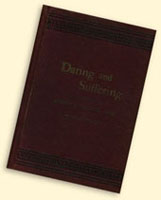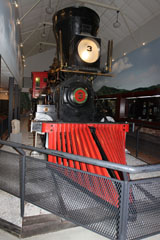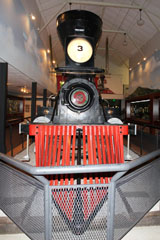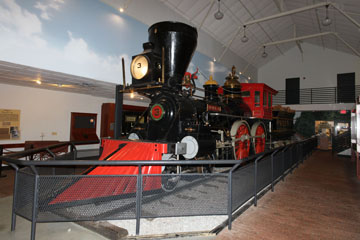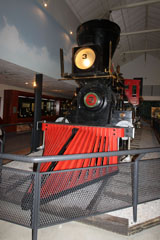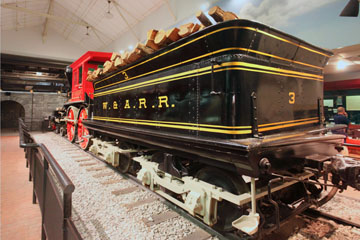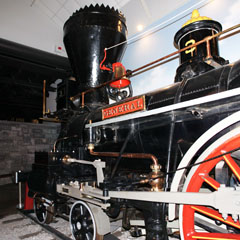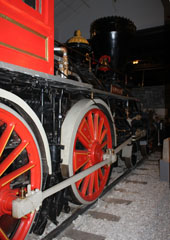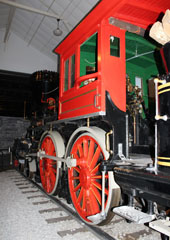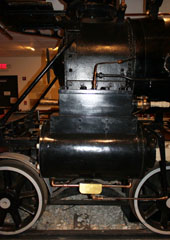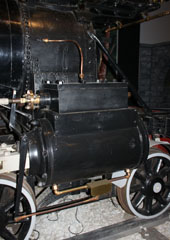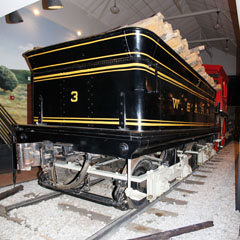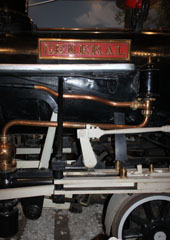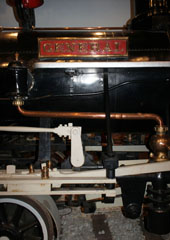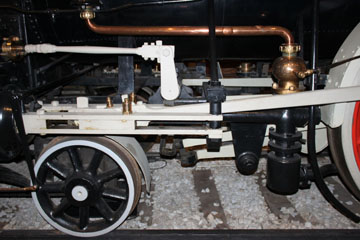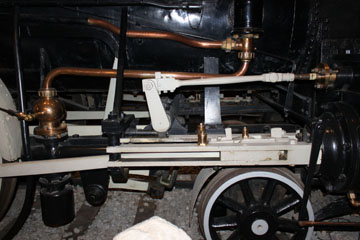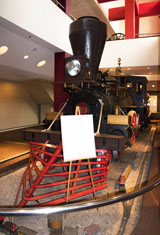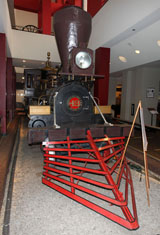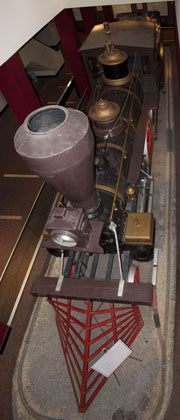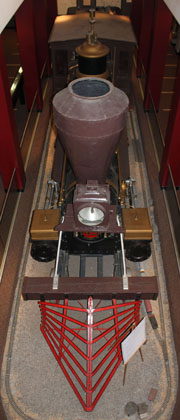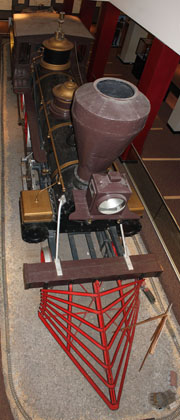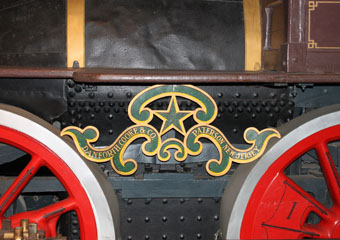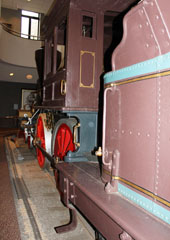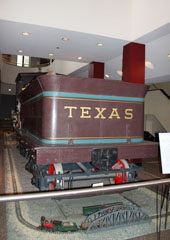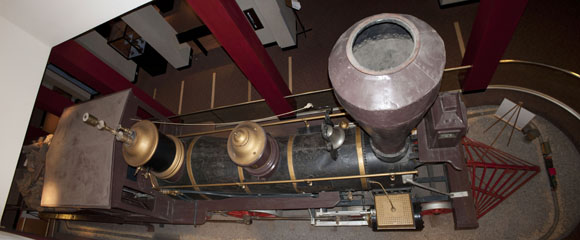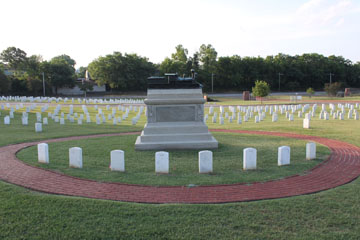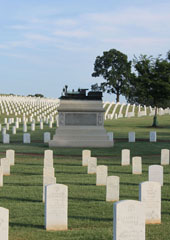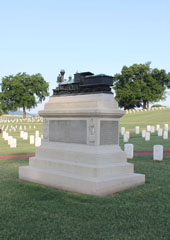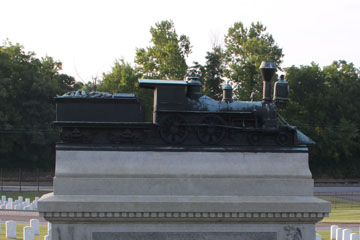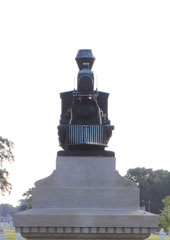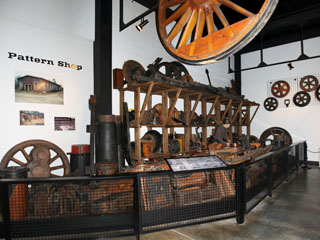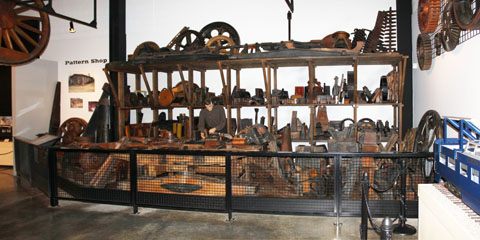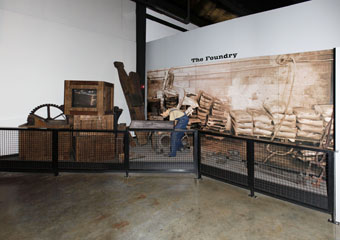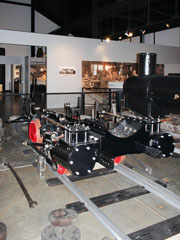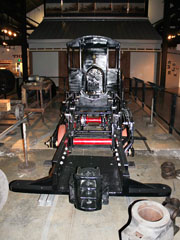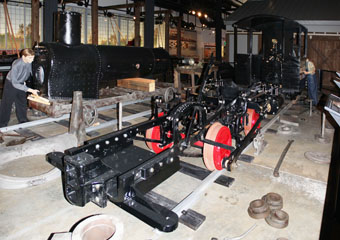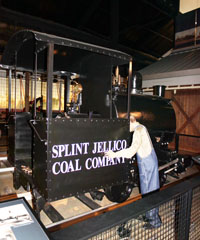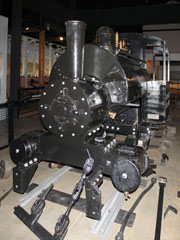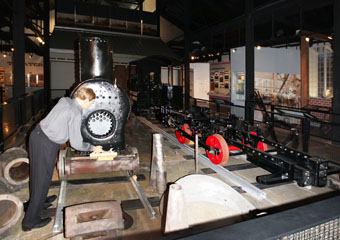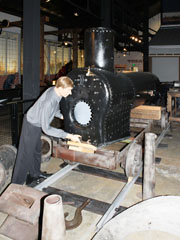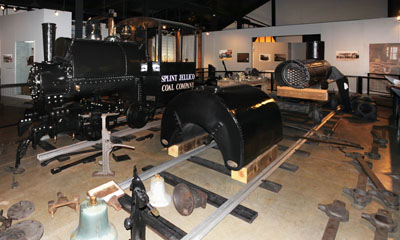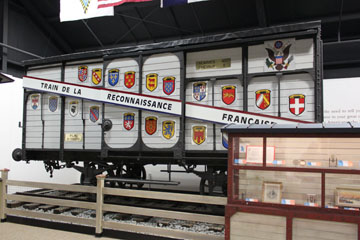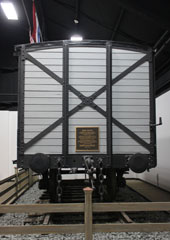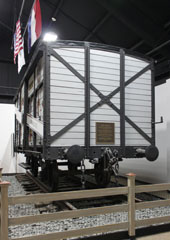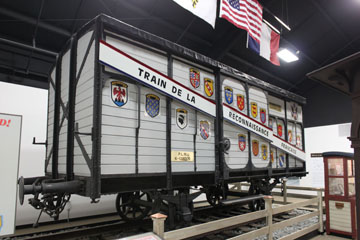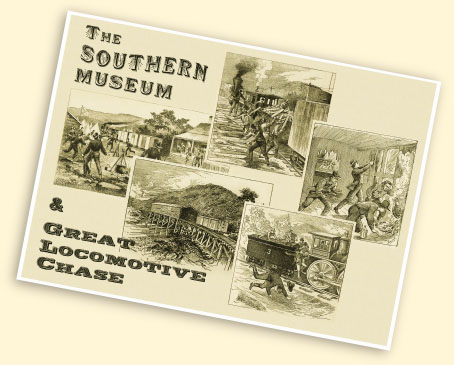

This page contains photos and information about the Marrieta, GA, based locomotive manufacturer, the Glover Machine Works as well as the Georgia "40 et 8" box car, but is primarily focussed on what is known as the "Great Locomotive Chase".
In early 1862, Brigadier General Ormsby Mitchel, commanding Union troops in central Tennessee, was planning an advance on Huntsville, AL, and then to attack towards the vital transportation hub of Chattanooga, TN. However, he lacked sufficient forces to block any Confederate counter attack that might come from Atlanta, GA, to the south of Chattanooga via the Western & Atlantic Railroad.
In response to this threat, the civilian scout James J. Andrews proposed a raid designed to sever the rail connection between the two cities. The plan was to proceed south through Confederate territory with a small force disguised in civilian clothes to seize a locomotive and then to steam north laying waste to the enemy's tracks and bridges along the way.

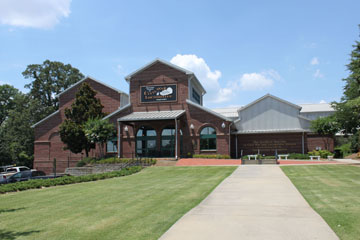
The Southern Museum of Civil War and Locomotive History houses artefacts from the American Civil War, as well as from railroads and locomotive manufacturers that operated in the State of Georgia and surrounding regions during the 19th and 20th Centuries. These include a collection of company records, engineering drawings, blueprints, glass plate negatives, photographs and correspondence from various railroad businesses, as well as a collection of Civil War letters, diaries and official records.
The museum started life in a barn that once housed a cotton gin as the Big Shanty Museum in 1972 with the steam locomotive "General" as its centrepiece and the museum subsequently expanded its collections to include additional Civil War material.
The museum closed in late 2001 to carry out a major expansion to accommodate its growing collection as well as a large number of artifacts and records donated by the Glover familly (details are shown later on this page). It reopened in 2003 as the Southern Museum of Civil War and Locomotive History. A further expansion was carried out in 2007 to house the recently acquired French "Merci Boxcar".

The main exhibit at the Southern Museum of Civil War and Locomotive History is the Western & Atlantic American type (4-4-0) locomotive the "General". It was built in 1855 to the Western & Atlantic's 5' gauge by Rogers, Ketchum & Grosvenor in Paterson, NJ (later part of Alco), along with four other American type locomotives, the "Governor", "President", "Senator" and "Chieftain".
Before the Civil War, the "General" hauled freight and passenger trains between Atlanta, GA, and Chattanooga, TN.
A wood burner, the "General" has an engine wheelbase of 20' 6", a driver wheelbase of 7' and weighs 50,000 lbs, 32,000 lbs on its 60" drivers.
With Stephenson valve gear, 15" x 22" cylinders, a 12.46 sq ft grate, 71 sq ft firebox and total heating surface of 819 sq ft, it operated at a boiler pressure of 120 psi delivering 8,415 lbs tractive effort.
The "General" is the most famous of four locomotives involved in what has come to be known as the "Great Locomotive Chase".
On 12th April 1862, it was commandeered at Big Shanty (now Kennesaw) by Union volunteers who had infiltrated Confederate territory in civilian clothing. Led by James J. Andrews, their goal was to take the train north towards Chattanooga and meet up with the Union's advancing army. Along the way, they would tear up track, sabotage switches, burn bridges and bring down telegraph lines.
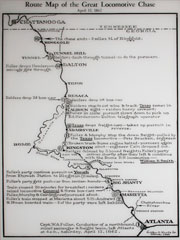
The train's conductor, William Allen Fuller, and two other men gave chase, first on foot and then by handcar. At Etowah, Fuller commandeered the "Yonah" and continued to Kingston. There, he switched to the "William R. Smith" but, two miles south of Adairsville, the tracks having been lifted by the raiders, Fuller
was forced to revert to foot. Arriving at Adairsville, he then took command of the southbound "Texas" and resumed his pursuit.
With the "Catoosa" following, both locomotives travelling tender-first, the chase continued north to Tunnel Hill, GA.
Finally, just north of Ringgold, GA, and only a few miles from Chattanooga, TN, with the locomotive out of fuel, Andrews' men abandoned the "General" and scattered. All the raiders were subsequently caught, however, and tried. Eight of those captured were executed as spies, and the remainder imprisoned. Some escaped and made it to the north, and the remainder were eventually paroled in exchange for Confederate prisoners.
After the war, the "General" continued to operate on the Western & Atlantic.
When the railroad began numbering engines, as it was the 39th acquired, the "General" was numbered #39. It was completely rebuilt in the 1870s and, in the mid 1880's, converted to standard 4' 8" gauge and leased to the Atlanta & Florida Railroad.
It retired from service in 1891 and was stored on a siding in Vinings, GA, until restored for display at the 1899 World's Columbian Exposition in Chicago. In 1901, it went on display in the Chattanooga Union Depot, although it was taken to the 1927 Fair of the Iron Horse in Baltimore, Chicago's "Century of Progress" Exhibition in 1933, the 1939 New York World's Fair and the Chicago Railroad Fair in 1948.
In 1959, the locomotive was restored to operating condition for the American Civil War Centennial and went on to appear at venues across the eastern US, including the 1964 New York World's Fair. A legal dispute then arose between the State of Georgia and the City of Chattanooga over custodianship, which was finally settled in 1970. The "General" then returned to Kennesaw where the museum site was being prepared for it.

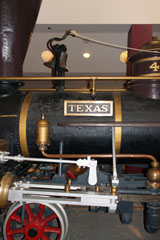
Although a total of four locomotives were involved at various stages in chasing the "General", the "Texas" ran the greatest distance
On 12th April 1862, the locomotive was hauling a twenty-one car train southbound from Dalton to
Atlanta. Bluffed into making way for the "General" at Adairsville, it was
then commandeered by Fuller to continue
the pursuit. Dropping its cars, the locomotive ran fifty miles at speeds approaching 60 mph, to close the chase
just north of
Ringgold.
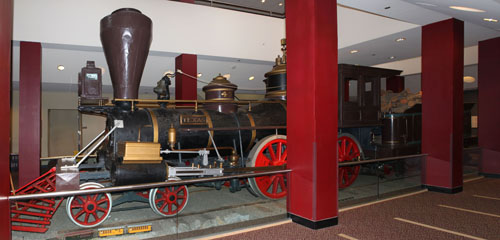
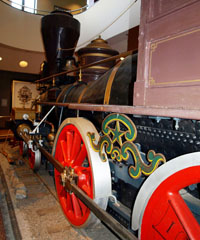
Built for the Western & Atlantic in 1856 at a cost of $9,050 by Danforth, Cooke and Co., later part of Alco, the "Texas" is an American type (4-4-0) locomotive. A wood burner like the "General", it has 15" x 22" cylinders and 57" drivers and was also designed to operate on 5' gauge track.
Before the war, the "Texas" ran freight and passenger services between Atlanta and Dalton, GA. In 1863, it was loaned to the East Tennessee & Virginia Railroad where it ended the war. Returned to the Western & Atlantic in 1866, it was renumbered #49
The "Texas" stood deteriorating in an Atlanta side yard until a campaign began to raise funds for its preservation. It was taken to Grant Park in 1911, but only moved indoors in 1921 when the Cyclorama building (below) was erected to house a panoramic painting of the Battle of Atlanta.
For many years, the "Texas" was stored in the basement. In 1936, historian Wilbur G. Kurtz led efforts to restore it to its wartime appearance, but it was not until 1981 that it moved upstairs to its current viewing area after modernisation of the Cyclorama building.
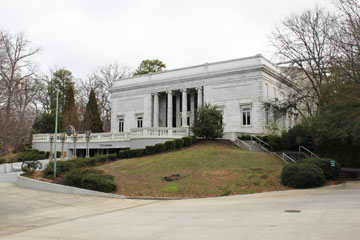
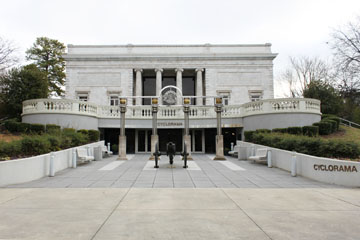

All eight raiders who were hanged are buried in Section H of the Chattanooga National Cemetery at the base of a granite monument bearing a bronze replica of the "General". The Andrews’ Raiders Monument, sometimes called the "Ohio Monument", was unveiled on Memorial Day 1891.
Nineteen of the twenty-two members of the raid were from Ohio regiments and the monument was erected by the State of Ohio in 1890. Six were the first to receive the Medal of Honor on 25th March 1863. The other thirteen later received the medal posthumously for the action.

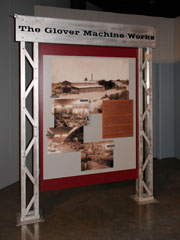
James Bolan Glover II bought the Phoenix Foundry and Machine Shop near downtown Marietta, Georgia in
1892. Three years later, the name was changed to the Glover Machine Works.
The company initially repaired locomotives made by other US builders, as well as producing a variety of railroad related equipment such as inspection cars, brake wheels and grate bars. By the early 20th Century, it had begun building steam locomotives for light industrial use and, between 1902 and 1930 it outshopped some two hundred locomotives.
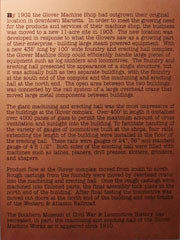
In the 1930s, locomotive production ceased, although the works continued to repair and replace parts for its engines until the 1950s. The bulk of the business was by then producing pipeline components in its Cordele, GA, plant.
By the late 1990s, having sat vacant for nearly fifty years, the buildings on the Marietta site were to be demolished.
However, they still contained many
company records, wood patterns, construction machinery and three Glover-built locomotives. This valuable set of historic material was donated to the museum by the Glover family in 2001.
The museum was extended between 2001 and 2003, and much of the floor space is now dedicated to reconstructions of parts of the original works.
On the left and below the Pattern Shop.
To create the component metal parts, patterns were passed to the Foundry (below) where they were pressed into specially prepared casting sand set in open frames called "flasks". The sand was then tamped down firmly and the resulting bottom half of the mould was called the "drag".
The drag was turned over and the pattern for the second half of the component was carefully laid in place. Another flask called the "cope" was then set on top of the drag and sand shovelled in and tamped down again.
Small tunnels in the mould allowed molten metal to be poured in and permitted the escape of hot gases. The drag and cope were then carefully separated and the wooden patterns removed. Finally, the mould was reassembled and clamped ready for casting.
Molten metal was brought in a ladle, and workmen ensured the pour went smoothly and no impurities made their way into the casting. Once the metal had cooled, the mould was opened, any sand was brushed off and the "nubs" (outcrops left after pouring) cut off.
The Pattern Shop was where skilled craftsmen, Pattern Makers, created wooden replicas of the various components of
locomotives working from blueprints. These were carefully built up from layers of different types of wood depending on the particular part. They were then cut, chiselled and sanded to create quite precise pieces. Most were made in halves, but some parts had to be constructed from several different wooden "patterns", and deciding how to break them into the various blocks in this way was a highly skilled job.
Finished patterns were varnished and stored like those on display in the photos above. Re-use allowed for some standardisation and repeatability within and across the company's orders.
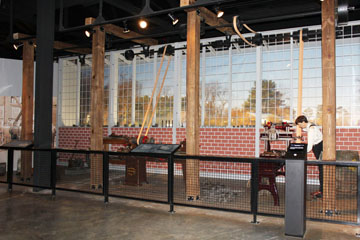
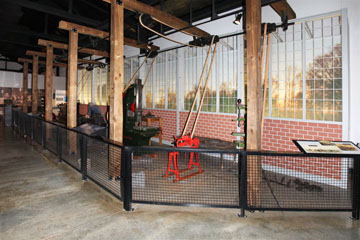
The rough cast components passed from the Foundry to the Machine Shop (above). Here, they would be ground, polished and finished in readiness for the Erecting Shop.
Many different tools were used in the Machine Shop, including lathes, shapers, planers, milling machines, presses, punches, boring machines, drills, saws and joiners. During the early part of the 20th Century at the Glover Machine Works, these were driven by belts run off overhead pulleys and shafts powered by a steam engine in a main boiler house.
Locomotives were assembled in the Erecting Shop, starting with the frame, to which the cylinders and boiler saddle were fitted first.
The brake rigging, valve gear and spring rigging followed, and any other components that would be difficult to fit once the boiler was in place.
The boiler was brought into the Erecting Shop on a cart (below) and lifted by overhead crane onto the frame. Once it was secured in place, the engine was lifted onto its wheels.
Steam and lubrication pipes were fitted, the boiler was lagged and the boiler jacket fitted.
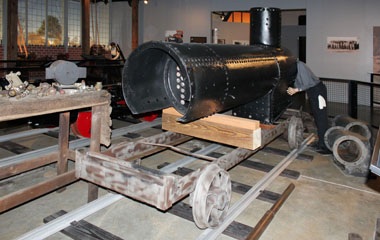
On display at the museum, this 0-4-0T (Tank) locomotive was built by the Glover Machine Works in June 1926 as #3 for the Splint-Jellico Coal Co., of Elk Valley, TN. However, Splint-Jellico could not keep up payments, so it was repossessed five months later and remained at the works progressively deteriorating over the next seventy or so years.
#3 was donated to the museum by the Glover family in 2001 along with most of the other historic material left at the Marietta, GA, site and has been nicely restored. A coal burner, #3 was built to a 40" gauge and has 23" drivers and 7" x 12" cylinders.

In gratitude, a group of French citizens organised a private effort to thank the people of the US for their assistance in the two world wars and for the relief aid. The result was the forty-nine box car “Merci Train”. The train arrived in New York aboard the steamship Magellan on 3rd February 1949.One box car was for each of the states, and one was to be shared between the District of Columbia, Alaska and Hawaii.
They were called “40 et 8” (40 and 8) cars because the French military rated them to carry forty soldiers or eight horses.
Related Links:
Southern Museum of Civil War and Locomotive History Website
Web Page on the Andrews Raid
Web Page with links on the Great Locomotive Chase
Atlanta Cyclorama Website
Send a comment or query, or request permission to re-use an image.
Westholme Publishing released Russell S. Bonds' highly readable history of the raid, Stealing the General, in 2008 (click on the cover to search for this book on Bookfinder.com).

For a first hand account, one the raiders, William Pittenger, published his story of the raid in Daring and Suffering in 1863. You can read the 1887 version, which includes a fifty-five page supplement updating the fate of the various participants, on the books and manuals page of this website.
